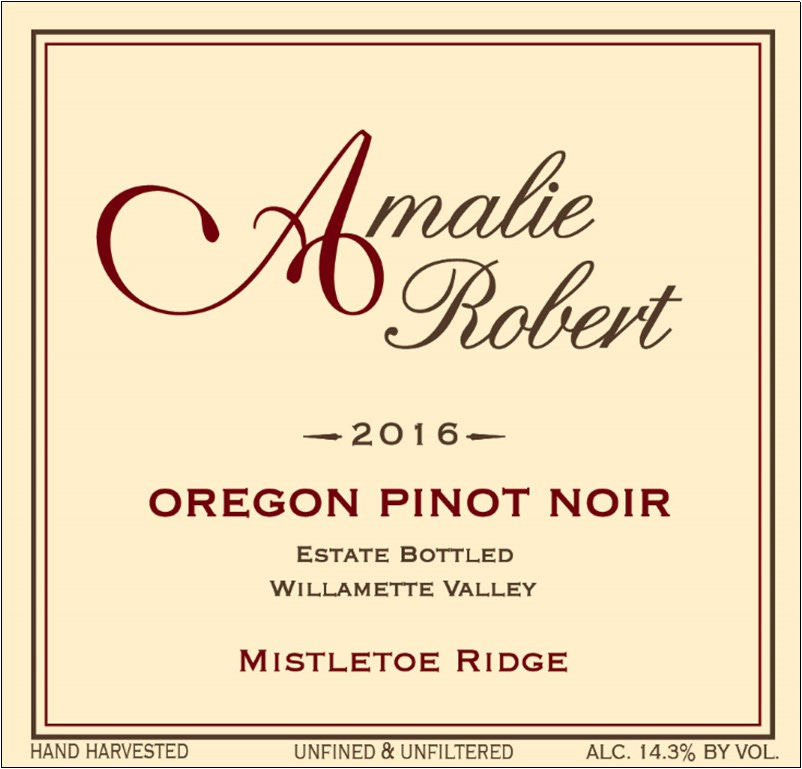Amalie Robert Estate: 2022 Spring Cellar Report
Hello and Welcome,
This is the Amalie Robert Estate 2022 Spring Cellar Report, Multi-Vintage Edition.
Pinot Meunier spring shoot growth, Vintage 2022.
Under “normal” circumstances, we would be blending and bottling our vintage 2020 Pinot Noirs right about now. However, due to environmental circumstances beyond our control (FIRE), resulting in a (YUGE) carbon footprint (SMOKE), we had to involuntarily abandon vintage 2020 due to “smoke affected grapes”.
And by now, the proverbial cat is out of the bag on what wine made with “smoke affected grapes” is all about. Hint: It’s not about aroma, flavor or texture. Smoke ‘em if you got ‘em.
The Big Picture
We have been waiting quite some time to share this with you. Our Mistletoe Ridge ™ Pinot Noir bottling was intended to celebrate the establishment of a sub-Willamette Valley AVA. However, the sub-Willamette Valley AVA in question has yet to be formally announced. The vintage is 2016. This is the same year the sub-Willamette Valley AVA petition was submitted. It has been a long 5+ years, and still we wait. But time and tide wait for no man.
Our 2016 Mistletoe Ridge ™ Pinot Noir is a 4 barrel selection from a very small area of the vineyard, less than 2 acres. The soil there is part of the Bellpine series, however it is very shallow and contains fractured ironstone. While fractured ironstone is not a root restrictive layer, it also does not hold very much soil moisture. Stones are just that way… Perhaps a sub-sub-AVA exists right here in a yet to be announced sub-Willamette Valley AVA? Too soon to tell, but the proof is in the soil and now the bottle.
Part of the discipline in laying out our vineyard was to isolate unique soil characteristics. We excavated several deep soil pits throughout our site and also took multiple soil core samples going down about 6 feet. This provided us with the intelligence we needed to match our rootstocks to our soil profile. It will come as no surprise to longtime readers of the FLOG, that this unique soil formation, elevation and aspect is planted to 5C rootstock, with the Pommard clone grafted on top. While we freely admit that it is better to be lucky than good, we also recognize that success favors the prepared mind.
Mistletoe Ridge ™ Pinot Noir from Amalie Robert Estate. “The Last Best Place to Grow Pinot Noir” ™
Note: You may notice the term “Hand Harvested” on the front label, right there in the fine print. Scroll up and have a look. It was supposed to be bigger, but label printing being what it is today, we ran with what we had. Last fall, we discovered there were THREE machine harvesters operating in our area. We thought it would be prudent to inform you that we are NOT machine harvesting, but obviously someone here is.
It is our opinion that machine harvesting deprives you of the opportunity to sort out lesser quality fruit. Whatever is on the vine is then in the machine, and for the most part, makes it into the fermenter. Fruit that was machine harvested is also lacking the stems. Hard to do whole cluster fermentation without the stems. And that broken piece of trellis post is not going to help anything.
We believe hand harvesting leads to better wine quality. Hand harvesting allows for us to sort whole clusters of fruit at the harvest bin and then again inside the winery for whatever was missed. If not caught and sorted out, a little rot here, and some underripe second crop there will degrade wine quality. Yes, it is more expensive and challenging to find harvest crews when you want to harvest. But our goal is the best wine on the planet and jeopardizing wine quality at harvest to save on cost is not an acceptable risk for us.
All that being said, those really cool green and red foils may be a thing of the past. We were recently informed that the lead time for foils in now ONE YEAR. While they look nice and complete our packaging, they have no impact on wine quality. We are sticking with the natural corks, however.
The Main Story
Since vintage 2020 was a write-off, we focused on the bounty of vintage 2021, what there was of it. Our highly aromatic 2021 white wines of Gewürztraminer and Viognier are crisp and clean on the palate with refreshing acidity. Fermented to dryness in stainless steel, these wines were bottled just before year end and are ready for prime time.
Our white to red transitional wine is Pinot in Pink Rosé. While this wine was ready to bottle in December, it seems that clear glass was one of the many victims of the dreaded supply chain SNAFU. There are other terms to describe the supply chain situation, and you can read about them here. How you choose to use these words is left to your good taste and adult discretion.
One would think that the folks that resell wineglass would have remembered that clear glass needs to be available to wineries in December and January. Alas, we were told to wait until late April and check back then. Our very first bottling was done in dark glass to satisfy early demand. Then thanks to Dena’s dogged efforts, she was able to outmaneuver Private SNAFU and bootleg some clear glass out of Washington state.
And Ernie worked a little winemaking magic to get the 2021 Pinot Meunier brought forward to enjoy now before its typical Thanksgiving release. As this wine does not spend any time in new barrels, it did not go to barrel at all. The reason we put Pinot Meunier in barrel is to allow it to go through its malo-lactic conversion over the winter months.
Well, not this year. Ernie used the same malo-lactic inoculum he would have put in the barrel but added it to the fermenter instead. The result was the primary sugar to alcohol fermentation finished at about the same time as the malic to lactic acid conversion. Then it was a racked off the spent yeast lees and allowed to settle in tank before it was bottled. All unfined and unfiltered as is de rigueur. There may be a little sediment in the bottle, but that is all the craze these days with natural wines.
What Does This Mean and Why Should I Care?
Looking ahead to Cold Shoulder vintage 2022, we see nasty business afoot. Jack Frost performed a little early shoot thinning for us. While we are not severely affected, there are some buds that just didn’t make it. But the secondary buds are now starting to come out. Oh bother…
Primary bud on the left, secondary bud starting to come out.
Another tough decision. What do we do with the secondary buds? If we leave them, then those clusters will be behind the primary bud’s clusters as we enter the Great Cluster Pluck. In other words, they will be underripe, and offer underripe aromas and flavors in the wine.
If we remove the secondary buds, we will just have the fruit from the primary buds. From a wine quality point of view, this is the best-case scenario. From a wine quantity point of view, there will be less wine to sell.
From a wine brand point of view this is a pretty easy decision to make. Not like vintage 2020, where doing the right thing for us was somewhat soul crushing. Vintage 2022 allows us another opportunity to help define our brand. It is important to remember that first and foremost, winegrowing is farming where we hope for the best and plan for the worst. The second important lesson here is that wine is a luxury good, and it should smell and taste that way.
Winemaking: The Continuation of Terroir by Other Means.® by Dena & Ernie is the repository of our farming history at Amalie Robert Estate. A FLOG communication (Farming bLOG). We have over 200 posts going back some 20 years. It’s all out there. More than you would ever want to know about farming wine. Check us out on Substack.
To see what we see, you can keep up with Vintage 2022 with our Instagram account @AmalieRobert. Estate grown, hand harvested Oregon Willamette Valley Pinot Noir, Chardonnay et al.
Kindest Regards,
Dena & Ernie







